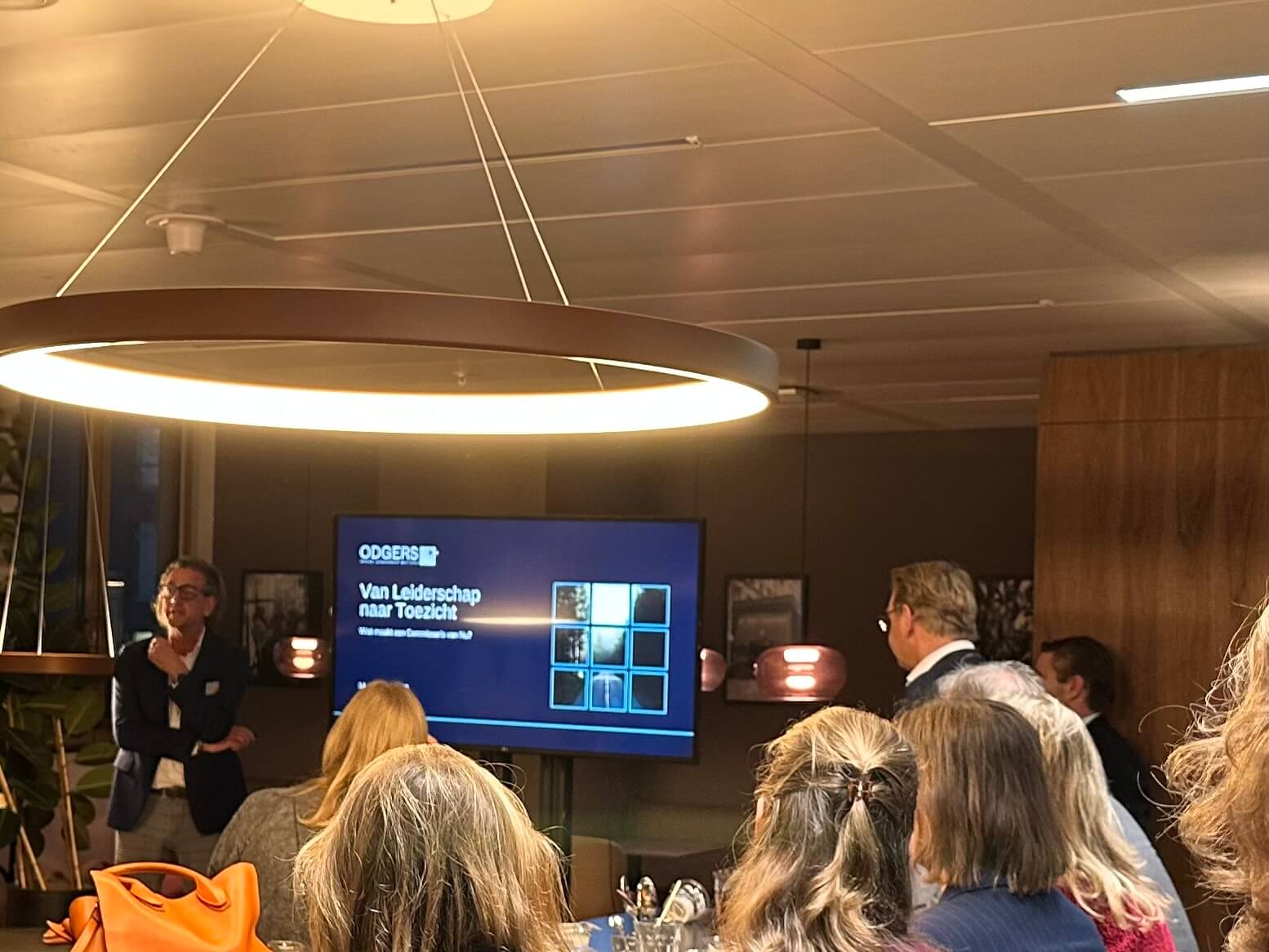This question sparked a lively discussion at Odgers’ Friday Breakfast Session last Friday. What makes a Supervisory Board (RvC) or Board of Trustees (RvT) effective today? The tension between proximity and distance struck a chord with attendees. As did the question: how do you bring the unspoken into the open?
During the session, Ed van der Sande (Partner, Leadership Practice) shared his views on boardroom dynamics, peer coaching and reflection, and the Supervisory Board as a team. He encouraged questions and contributions throughout, which led to an engaged conversation among a diverse group of participants: experienced supervisory board members and leaders considering a move into supervision.
Supervision is more than compliance
Training for supervisory board members often concentrates on role, responsibilities and legislation. Van der Sande argues the emphasis should instead be on boardroom dynamics and on intervision and reflection. ‘Supervisors spend too little time on these areas, while they form the foundation for success,’ he says, drawing on research and the self-evaluations he regularly facilitates.
What every Supervisory Board recognises
From his experience, Van der Sande identifies five recurring issues in the RvCs and RvTs he supports. First, the connection with the organisation’s activities is essential. Getting to know the organisation matters, but in practice that learning consumes too much time during meetings. ‘Before you know it, you’ve spent an hour and a half on presentations,’ he says. His advice: reorganise how you receive that information.
‘Second, many boards do not genuinely debate,’ Van der Sande adds. His third point follows on: the quality of conversations needs to improve.
There is a lack of sharpness in discussions, including in exchanges between supervisors and the executive board.
When asked from the floor why this happens, Van der Sande points to a familiar cause: haste and lack of time. ‘A lot of time is spent on what you must do as a supervisor and too little on what you need to fulfil the role properly,’ he explains.
The fourth point is that the sounding-board/advisory role should be more fully developed. Van der Sande explains this involves truly interacting about direction and how supervisors can contribute, a point that resonated with the room. The fifth issue is insufficient investment in team development, something he observes across sectors.
Supervision requires different skills
As an executive you are focused on directing, accelerating and intervening. In a supervisory role, giving space, slowing down and reflecting are far more important.
It asks something different of you than you are used to.
You are not an executive, but you are not an outsider either. You are engaged, but not operational. You are accountable, but not responsible for execution. How do you navigate this tension between proximity and distance? ‘You all know this,’ Van der Sande says with a smile, ‘but I still challenge you: think about how you handle it. When do you step in, and when do you stand back?’
Attendees recognised how these tensions create tricky situations. One participant mentioned the habit of avoiding the use of ‘we’ or ‘you’ in conversation: ‘“We” feels inappropriate because as an RvC member you must be independent, and “you” comes across as preachy.’ Van der Sande recognises the dilemma. ‘In the advisory role people talk about “we”, and in the control role about “you”. Name that feeling in the RvC, put it on the table and find a shared way forward,’ he advises.
What makes a supervisory board member successful?
‘A supervisory board member understands boardroom dynamics, has self-insight, complements the team and dares to slow down and reflect,’ Van der Sande states. ‘You also need an eye for the relationship with the executive board, which has its own dynamics that play out in joint meetings. That alignment matters too.’
One participant highlighted the balance between intervening and letting go, especially when the executive board stages a ‘good-news show’. Rather than coaching someone afterwards, it is crucial to ‘name the elephant in the room in the moment,’ says Van der Sande. ‘You feel it, but few dare to say it,’ he adds.
Preparing for a Supervisory Board role
Preparation starts with self-reflection, role awareness, listening without judgement and voicing the unspoken. ‘Listening without judgement is the most important thing of all,’ Van der Sande says. Asked why technical expertise was not mentioned, his response was clear: ‘Subject-matter knowledge is part of the basics and is taken into account when selecting the right person.’
From individuals to an effective team
Van der Sande stresses that a Supervisory Board is not a collection of individuals. ‘It is a team with a shared purpose, collective responsibilities, clear role distribution and mutual dependence,’ he says. ‘The focus must therefore be on making that team as effective as possible.’ That requires trust and openness, constructive conflict, a shared vision and moments for reflection and evaluation.
We don’t always have a positive image of engaging in conflict, but it helps enormously to reach better decisions.
The ideal RvC blueprint provides clarity
Understanding what you bring as a team member, exploiting each other’s strengths and recognising vulnerabilities: Van der Sande describes an RvC assessment model they have developed that looks at the competencies and drivers individuals bring to the team.
He illustrated this with slides showing how individual competencies and drivers compare with the ‘box’ of an ideal RvC profile.

This blueprint is based on international research. ‘It’s fine if someone falls outside that box,’ he emphasises, ‘as long as you know it about yourself. If you’re not very empathetic, let another board member take the lead when empathy is required. Use each other’s strengths.’
After reviewing several competencies, Van der Sande concluded: ‘In about a third of supervisory board members we see areas for attention. They are less sensitive, tend to want to steer, push the accelerator first and ask forgiveness later, and challenge others less. Once you recognise that, you can decide what to do about it.’

Among the drivers he presented, RvC members score relatively highly on self-reliance, autonomy, innovation, experimentation and generosity. ‘Around 70% of RvC members want to seize opportunities and take risks themselves, but it’s worth considering whether that is always appropriate in a supervisory role,’ Van der Sande notes.
Making the dilemma discussable
‘The thing I would most like is to sit in on an RvC meeting as a fly on the wall. I’d recommend it because you see the patterns we’ve discussed today,’ he says. Some participants reported that not everyone is open to speaking up. ‘It takes personal courage, but it can be very liberating,’ one attendee observed. Van der Sande agrees: ‘It requires courage and sometimes a period of adjustment, especially for old-school RvCs. But do it! It will move the board forward.’
The takeaways Van der Sande leaves participants with are: make time for reflection and intervision, use each other’s strengths and address the undercurrent. Several attendees then shared practical tips for applying these ideas in day-to-day practice.
From passer-by to sparring partner
For many RvCs, the self-evaluation is an annual box-ticking exercise. A missed opportunity, says Van der Sande, because there is much more to gain. ‘That is why we at Odgers advocate long-term collaborations,’ he says. In his view, that means a comprehensive self-evaluation every three years, lighter self-evaluations in the intervening years (the so-called difficult conversations), and embedding team complementarity in searches for new RvC members.
‘That creates stability, elevates the level of discussion and helps RvC members get to know each other differently. That makes it easier to tackle the unspoken,’ he says. ‘And to answer, as a Supervisory Board, the question: are we doing the right things?’
___________________________________________________________
Would you like to explore the Supervisory Board role further? Contact Ed van der Sande.

Never miss an issue
Subscribe to our global magazine to hear our latest insights, opinions and featured articles.
Follow us
Join us on our social media channels and see how we're addressing today's biggest issues.



